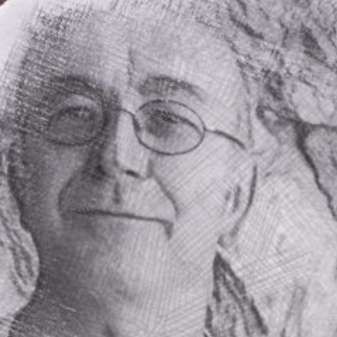In her short introductory remarks at the evening’s outset, Sally Beamish referenced Oscar Wilde’s The Nightingale and the Rose, wherein in the redness of a rose is secured by a nightingale’s pierced heart. The 14th-century poet Hafez, around whose works this multimedia event was constructed, hailed from the Persian (Iranian) city of Shiraz, nicknamed “City of roses” and “City of flower and nightingale”.
Red Note Ensemble felt the perfect complement to their own take on verses from the Divan-e-Hafez to be a comparatively spare rendering by Iranian musician Anoosh Jahanshahi. This portion of the evening might have been even more spare, had the far-from-certain task of procuring a visa to leave Iran not worked out.
All’s well that ends well. In a seamless set, he sang and accompanied himself on his mulberry and walnut wood setar. This Persian member of the lute family resembles a slender bouzouki. Despite its etymology (seh = three; tar = string) the instrument now bears four strings, the fourth having been added in the 18th century. It is strummed with the index finger in accompaniments which feature both melodies and drones. Various re-tunings were undertaken to allow changes of key and mode. To my untrained ear, the most noticeable interval seemed to be a very flattened second, whose strong pull, downwards to the central key note, lends drive and urgency to songs which often remain on, or around, one chord. I found Jahanshahi’s performance very engaging. The vocal style is a little harder and more throat-based than Western-style classical singing, and it allows for very affecting ornamentation which seems to be done by allowing the voice to oscillate either side of its “break”. The chosen verses, like those in Beamish’s piece, were named after animals and featured such themes as love, the human condition and separation from the Beloved. There was a very warm response to this simple and heartfelt performance.
The inception of Sally Beamish’s The Intoxicating Rose Garden dates from 2007, when Iranian-born Jila Peacock introduced her to the ancient Persian technique of “figural calligraphy”. This involves poems whose word layout creates a picture of the content. Soon both felt that “translation” needed movement, and Michael Popper was invited to choreograph and perform along with members of Red Note Ensemble. His contribution involved singing Hafez’s words in addition to dancing. In the resulting multimedia event, eight verses are scored for trumpet, harp, flute and cello. Additional crotales were played by Popper and trumpeter Mark O’Keeffe. Laurie Irvine’s large-screen video backdrop to all of this featured snippets of musicians’ hands at work on their instruments in addition to Peacock’s calligraphic art. The most engaging, for me, featured in the second piece when characters from the Persian Nast’aliq script dropped gradually into place, forming the eponymous nightingale. The entire process and the final image were beautiful.
Four of the featured verses concerned birds: two on the hoopoe and one each on nightingale and falcon. Unsurprisingly there was much melodic interest for Ruth Morley’s flute, and I thought I noted an ear-catching, questioning three-note ascending motif binding the work together. Much of the thoroughly engaging harmony was ably supplied by harpist Pippa Tunnel. These often dense sounds contrasted effectively with Jahanshahi’s leaner harmonies in the first half. The ensemble was extremely impressive. At one point, between trumpet phrases, Mark O’Keeffe conducted a short passage, but tightness was otherwise secured by excellent chamber musicianship and thorough knowledge of this very engaging score.
Michael Popper was a very physical presence. His vocal part, often restricted to a single, repeated note, or a very narrow range, was combined with movement. In more energetic breathless moments, he departed from the text to devote finite breath to the dance. Some moves bore the character of the featured animal, the finest such example being the third movement, “Deer”. Others, involving a pair of sticks, brought to mind the Filipino martial art eskrima. Yet others, “Fish” and “Lion”, made energetic use of a pair of scarves.
Absorbing the various elements, I was reminded of line in the programme note of Red Note’s co-artistic director, John Harris (his co-artistic director, Robert Irvine, was meanwhile engaged in some virtuosic cello work): “... we can only learn from this act of multiple translation – translation not only in the linguistic sense but also translation from Persia to Scotland, from text into song, from text into image, and thence into music, dance and animation.”
The stillness of the audience throughout the evening and the warmth of their response to this fine performance, endorsed a line so central that it not only appears in the first “Hoopoe” piece, but ends the whole work:
In quest of love
There is no near or far but only
now


